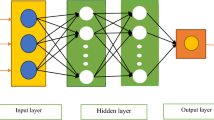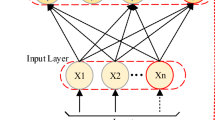Abstract
Flowing bottom hole pressure (FBHP) is an indication of the fluid pressure in a porous reservoir under production. FBHP is obtained using a permanent gauge, well-testing analysis, or developing a mechanistic/correlation model. These conventional methods are costly and can be unreliable in the case of mechanistic/correlation approach. In line with this, the present study proposes the application of M5 prime for evaluating the FBHP of a well having a multiphase flow system. The proposed M5 prime FBHP model was further compared with backpropagation neural network (BPNN), generalised regression neural network (GRNN), radial basis function neural network (RBFNN), least-squares support vector machine (LSSVM), and group method of data handling (GMDH) to ascertain its performance. The M5 prime was identified as the superior technique as it attained the highest coefficient of determination (R2), correlation coefficient (R), the variance accounted for (VAF), and performance index (PI) values of 0.985, 0.99, 98.5, and 1.9, respectively, during testing. From the analysis of the contribution of each input variable, it was discovered that the tubing head pressure (THP) was the most dominant variable followed by the oil production flow rate (Qo), with the gas rate (Qg) having the least influence on the M5 prime outcome. Therefore, conclusion can be drawn that the proposed M5 prime model represents the best performing method as it can generate a more robust FBHP estimation while accounting for a superior variance of the measured data.





Similar content being viewed by others
References
Abdelkader SS, Grolinger K, Capretz MA (2015) Predicting energy demand peak using M5 model trees. In: 2015 IEEE 14th International Conference on machine learning and applications (ICMLA), pp 509–514
Abdollahi F, Hosseini S, Sabet M et al (2020) A novel study of the gas lift process using an integrated production/injection system using artificial neural network approach. Model Earth Syst Environ. https://doi.org/10.1007/s40808-020-00958-9
Adeoti OA, Osanaiye PA (2013) Effect of training algorithms on the performance of ANN for pattern recognition of bivariate process. Int J Comput Appl 69(20):8–12
Ahmadi MA, Galedarzadeh M, Shadizadeh SR (2016) Low parameter model to monitor bottom hole pressure in vertical multiphase flow in oil production wells. Petroleum 2:258–266. https://doi.org/10.1016/j.petlm.2015.08.001
Akinsete, O., Adesiji, B.A (2019) Bottom-hole pressure estimation from wellhead data using artificial neural network. SPE-198762-MS. In: Nigeria Annual International Conference and Exhibition, Lagos, Nigeria, 5–7 August 2019.
Alipour A, Yarahmadi J, Mahdavi M (2014) Comparative study of M5 model tree and artificial neural network in estimating reference evapotranspiration using MODIS products. J Climatol. https://doi.org/10.1155/2014/839205
Amar MN, Zeraibi N, Redouane K (2018) Bottom hole pressure estimation using hybridization neural networks and grey wolves optimization. Petroleum 4:419–429. https://doi.org/10.1016/j.petlm.2018.03.013
Ansari AM, Sylvester ND, Shoham O, Brill JP (1990) A comprehensive mechanistic model for upward two phase flow in Wellbores. In: 65th annual technical conference and exhibition. https://doi.org/10.2118/20630-MS
Asante-Okyere S, Shen C, Ziggah YY, Rulegeya MM, Zhu X (2018) Investigating the predictive performance of Gaussian process regression in evaluating reservoir porosity and permeability. Energies 11(12):3261
Asante-Okyere S, Shen C, Ziggah YY, Rulegeya MM, Zhu X (2020) A novel hybrid technique of integrating gradient-boosted machine and clustering algorithms for lithology classification. Nat Resour Res 29(4):2257–2273
Ashena R, Moghadasi J (2011) Bottom hole pressure estimation using evolved neural networks by real coded ant colony optimisation and genetic algorithm. J Pet Sci Eng 77:375–385
Awadalla M, Yousef H, Al-Shidani A, Al-Hinai A (2016) Artificial intelligent techniques for flow bottom hole pressure prediction. Int J Comput Ampl Tech 15(12):7263–7283. https://doi.org/10.24297/ijct.v15i12.4354
Ayoub MA, Negash BM, Saaid IM (2015) Modelling pressure drop in vertical wells using group method of data handling (GMDH) approach. In: Awang M, Negash B, Md Akhir N, Lubis L (eds) ICIPEG 2014. Springer, Singapore. https://doi.org/10.1007/978-981-287-368-2_6
Aziz K, Govier GW (1972) Pressure drop in wells producing oil and gas. J Can Pet 11:38–48. https://doi.org/10.2118/72-03-04
Baraka MN, Shen C, Asante-Okyere S, Mulashani AK, Chungu J, Wang L (2020) Prediction of permeability using group method of data handling (GMDH) neural network from well log data. Energies 13(3):551
Beggs DH, Brill JP (1973) A study of two-phase flow in inclined pipes. J Pet Technol 25(05):607–617. https://doi.org/10.2118/4007-PA
Bobeda GRR, Combarro EF, Mazza S, Gimenez LI, Diaz I (2018) Using regression trees to predict citrus load balancing accuracy and costs. Int J Comput Intell Syst 12:79–89
Chen E, He XJ (2019) Crude oil price prediction with decision tree based regression approach. J Int Technol Inf Manag 27(4):2–16
Chokshi RN, Schmidt Z, Doty DR (1996) Experimental study and the development of a mechanistic model for two-phase flow through vertical tubing. In: SPE Annual Technical Conference and Exhibition, SPE-35676-MS, West Region Meeting, 22–24 May, Anchorage, Alaska, 1996.
Diaz I, Mazza SM, Combarro EF, Gaiad GLI, JE, (2017) Machine learning applied to the prediction of citrus production. Span J Agric Res 15(2):1–12. https://doi.org/10.5424/sjar/2017152-9090
Duns Jr H, Ros NCJ (1963) Vertical flow of gas and liquid mixtures in wells Section II, paper 22-PD 6. In: Proceedings of Sixth World Petroleum Congress WPC-10132 pp 451–465.
Esmaili S, Mohaghegh SD (2016) Full field reservoir modelling of shale assets using advanced data-driven analytics. Geosci Front 7:11–20
Firouzi M, Rathnayake S (2019) Prediction of the flowing bottom-hole pressure using advanced data analytics. In: Paper presented at the SPE/AAPG/SEG Asia Pacific Unconventional Resources Technology Conference, Brisbane, Australia, November 2019, https://doi.org/10.15530/AP-URTEC-2019-198240
Gacto MJ, Soto-Hidalgo JM, Alcala-Fdez J, Alcala R (2019) Experimental study on 164 algorithms available in software tools for solving standard non-linear regression problems. IEEE Access. https://doi.org/10.1109/ACCESS.2019.2933261.108916-108939
Garg A, Tai K, Lee CH et al (2014) A hybrid M5-genetic programming approach for ensuring greater trustworthiness of prediction ability in modelling of FDM process. J Intell Manuf 25:1349–1365. https://doi.org/10.1007/s10845-013-0734-1
Gomez LE, Shoham O, Schmidt Z, Chokshi RN, Northug T (2000) Unified mechanistic model for steady-state two-phase flow: horizontal to vertical upward flow. SPE J 5:339–350
Gray HE (1974) Vertical flow correlation in gas wells, User Man. In: API14B, in: Subsurf. Control. Saf. Valve Sizing Comput. Progr.
Guo B, Lyon WC, Ghalambor A (2007) Production engineering, a computer assisted approach. Elsevier and Science and Technology Books, p 288
Hagedorn AR, Brown KE (1965) Experimental study of pressure gradients occurring during continuous two-phase flow in small-diameter vertical conduits. J Pet Technol 17(4):475–484. https://doi.org/10.2118/940-PA
Handhal AM (2016) Prediction of reservoir permeability from porosity measurements for the upper sandstone member of Zubair Formation in Super-Giant South Rumila oil field, southern Iraq, using M5P decision tress and adaptive neuro-fuzzy inference system (ANFIS): a comparative study. Model Earth Syst Environ 2:111. https://doi.org/10.1007/s40808-016-0179-6
Hastie T, Tibshirani R, Friedman J (2001) The elements of statistical learning: data mining, inference, and prediction. Springer, New York
Huang X, Wang S (2018) Prediction of bottom-hole flow pressure in coalbed gas wells based on GA optimization SVM. In: IEEE 3rd advanced information technology, electronic and automation control conference. https://doi.org/10.1109/IAEAC.2018.8577488
Jekabsons G (2016) M5PrimeLab: M5' regression tree, model tree, and tree ensemble toolbox for Matlab/Octave. Available at http://www.cs.rtu.lv/jekabsons/. Accessed 21 Mar 2021
Marfo SA, Kporxah C (2020) Predicting oil production rate using artificial neural network and decline curve analytical methods. In: Proceedings of 6th UMaT biennial international mining and mineral conference, Tarkwa, Ghana. http://conference.umat.edu.gh/wp-content/uploads/2020/08/Predicting-Oil-Production-Rate-Using-Artificial-Neural-Network-and-Decline-Curve-Analytical-Methods.pdf. Accessed 21 Mar 2021
Mathias AC, Rech PC (2012) Hopfield neural network: the hyperbolic tangent and the piecewise-linear activation functions. Neural Netw 34:42–45
Mirzaei-Paiaman A, Salavati S (2012) The application of artificial neural networks for the prediction of oil production flow rate. Energy Sourcwes Part A Recov Util Environ Effects 34(19):1834–1843
Mohaghegh S (2000) Virtual-intelligence applications in petroleum engineering: part 1–artificial neural network. J Petrol Technol 52(9):64–73
Mohaghegh SD (2011) Reservoir simulation and modelling based on artificial intelligence and data mining (AI and DM). J Nat Gas Sci Eng 3:697–705
Mohammadpoor M, Shahbazi KH, Torabi F, Qazvini A (2010) A new methodology for prediction of bottomhole flowing pressure in vertical multiphase flow in iranian oil fields using artificial neural networks (ANNs). In: Proceedings of SPE Latin American & Caribbean petroleum engineering conference SPE 139147. https://doi.org/10.2118/139147-MS
Mukherjee H, Brill JP (1985) Pressure drop correlations for inclined two-phase flow. J Energy Res Technol 107:549. https://doi.org/10.1115/1.3231233
Muller AV, Hemond HF (2013) Extended artificial neural networks: incorporation of a priori chemical knowledge enables use of ion selective electrodes for in-situ measurement of ions at environmentally relevant levels. Talanta 117:112–118
Okon AN, Adewole SE, Uguma EM (2020) Artificial neural network model for reservoir petrophysical properties: porosity, permeability and water saturation prediction. Model Earth Syst Environ. https://doi.org/10.1007/s40808-020-01012-4
Pucknell JK, Mason JNE, Vervest EG (1993) An evaluation of recent “mechanistic” models of multiphase flow for predicting pressure drops in oil and gas wells. In: Offshore Europe. Society of Petroleum Engineers.
Quinlan JR (1992) Learning with continuous classes. In: 5th Australian joint conference on artificial intelligence, vol 92, pp 343–348
Ramgulam A, Ertekin T, Flemings PB (2007) An artificial neural network utility for the optimization of history matching process. In: Society of petroleum engineers Latin American and Caribbean petroleum engineering conference, Buenos Aires, Argentina. https://doi.org/10.2118/107468-MS
Shen C, Asante-Okyere S, Ziggah YY, Wang L, Zhu X (2019) Group method of data handling (GMDH) lithology identification based on wavelet analysis and dimensionality reduction as well log data pre-processing techniques. Energies 12(8):1509
Srivastava R, Tiwari AN, Giri VK (2019) Solar radiation forecasting using MARS, CART, M5, and random forest model: a case study for India. Heliyon 5(10):02692
Tariq Z, Mahmoud M, Abdulraheem A (2020) Real-time prognosis of flowing bottom-hole pressure in a vertical well for a multiphase flow using computational intelligence techniques. J Pet Explor Prod Technol 10:1411–1428. https://doi.org/10.1007/s13202-019-0728-4
Taylor KE (2001) Summarising multiple aspects of model performance in a single diagram. J Geophys Res 106:7183–7192
Temeng VA, Ziggah YY, Arthur CK (2021) Blast-induced noise level prediction model using brain inspired emotional neural network. J Sustain Min 21(1):28–39
Author information
Authors and Affiliations
Corresponding author
Ethics declarations
Conflict of interest
The authors declare that they have no conflict of interest with respect to the research, authorship, and/or publication of this article.
Additional information
Publisher's Note
Springer Nature remains neutral with regard to jurisdictional claims in published maps and institutional affiliations.
Rights and permissions
About this article
Cite this article
Marfo, S.A., Asante-Okyere, S. & Ziggah, Y.Y. A new flowing bottom hole pressure prediction model using M5 prime decision tree approach. Model. Earth Syst. Environ. 8, 2065–2073 (2022). https://doi.org/10.1007/s40808-021-01211-7
Received:
Accepted:
Published:
Issue Date:
DOI: https://doi.org/10.1007/s40808-021-01211-7




